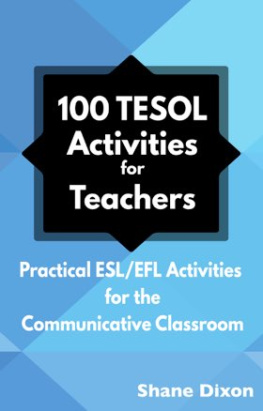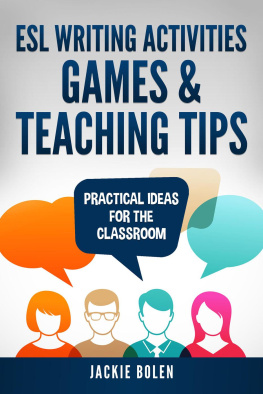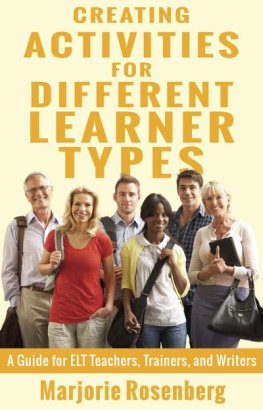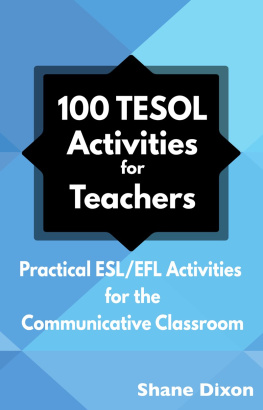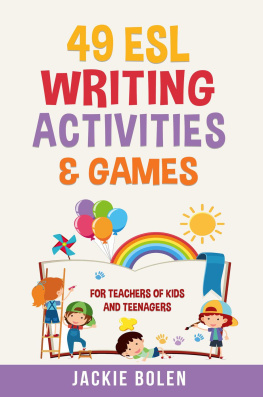All rights reserved. No part of this publication may be reproduced, stored in or introduced into a retrieval system, or transmitted, in any form, or by any means (electronic, mechanical, photocopying, recording, or otherwise) without the prior written permission of the copyright owner.
Cover design by DJ Rogers.
Edited by Dorothy Zemach.
Published in the United States by Wayzgoose Press.
How To Use This Book
Most teachers use a textbook in class, which provides both instruction and practice but, often, not enough practice. Students need to practice again and again and in different ways, not just to keep their interest, but also to both learn and remember.
This book provides ideas to help your students become proficient at using English pronunciation. It can be used with any textbook or without any textbook at all. It tells you how to integrate pronunciation into your lessons, it suggests fun ways to practice key pronunciation skills; and it gives you games and warm-ups that can be added to any class.
Not every idea will work for every student or for every class. Thats why there are fifty. We feel sure that many of the ideas presented here will bring you results if you try them sincerely and practice them regularly.
Here is a suggested method for using this book:
- Read through all of the fifty tips without stopping.
- Read through the tips again. Choose one or two tips for each skill that you think might work for your class. Decide when you will try them.
- Choose different types of ideas: some that can be done independently, and some that work along with your textbook
- Each time you use one of the ways, make a note about how well it worked for your class and why. Remember that most of the tips will work best if you use them several times (or even make them a habit). Dont try a tip only once and decide its no good for your students. Give the tips you try a few chances, at least.
- Every few weeks, read through the tips again, and choose some new ones. Discontinue using any methods that are not working for you.
Finally, consider trying some of the other books in our 50 Ways to Teach Them series. No one skill in English is really separate from the others. Speaking, listening, reading, writing, vocabulary, and grammar are all connected. Students who improve in one area will almost always improve in other areas too.
Introduction
This book is intended for teachers who are new to ESL/EFL, teachers who are new to teaching English pronunciation, and teachers who are looking for more interactive activities for their English classes. Though the suggestions in this book have a strong theoretical basis, this isnt an exploration of research and pedagogy, but a list of activities and tips for making activities more effective.
This book suggests activities for a variety of core pronunciation features. You may decide that, since accurate pronunciation is an essential part of a successful interaction, you want to cover all the skills over the course of the term or semester, introducing them one by one through brief explicit instruction and then following up with practice. Or, you may decide that you will deal with pronunciation by adopting a triage approach, analyzing the errors of your students and providing explicit instruction and practice on only the features which they need to work on in order to improve their comprehensibility. You will know what approach will work best for your learners and within the confines of your curriculum.
Not all these activities may work for your class exactly as written. It is always beneficial to look at an idea and think about how you could adapt it to fit your own context. When you read an idea, think about how you could change it to fit your students ages, levels, culture, and interests. All of these things are important to think about carefully when bringing pronunciation instruction and practice into a lesson.
Some of these activities can be modified to accompany or supplement a textbook. However, as many ESL and EFL texts offer little pronunciation instruction and practice for students (Kanellou, 2009), and because students need repeated practice with pronunciations skills, this book also provides opportunities to go beyond the limited selection of activities your textbook might provide. As well, think outside the speaking box. Connecting it to other skills gives students more practice and helps their overall English proficiency to increase.
While the level of your learners is also an important consideration. Dont be tempted to wait until your students are at a higher level to begin integrating pronunciation practice into your lessons (Gilbert, 2014). Even true beginners benefit from pronunciation practice. As students learn words, they can also learn the word stress. As they learn how to make short sentences, they can learn how to apply speech rhythm to the phrases they are memorizing. By introducing pronunciation as a natural part of comprehensible communication early on, it can reduce students frustration later on.
It is helpful to remember that, as the number of non-native English speakers has exceeded the number of native English speakers around the world, most educators find the emphasis of their pronunciation teaching has moved away from the (nearly impossible) goal of a native-like accent and toward the goal of intelligibility (Grant, 2014). So, as you sift through the suggestions in this book, think about what pronunciation errors are causing your students to be misunderstood.
This book is divided into 6 core pronunciation features:
- Word Stress
- Speech Rhythm
- Speech Groups
- Final Intonation and Focus
- Linking and Blending
- Consonants and Vowels
Each of these pronunciation features is essential for students who want to communicate intelligibly. Although they are often separated for pedagogical reasons, they actually intertwine when we speak and listen. For instance, the vowel sounds in a peak [or stressed] syllable are crucial (Gilbert, 2008, page21) for students to accurately stress English words and sentences.
Similarly, if students struggle to accurately produce English consonant sounds, they may have trouble with linking and blending between words when they speak and, as a result, may not be able to understand the connected speech [that] is typical of spoken English [and] found in all registers and all rates of speech. (Celce-Murcia, Brinton and Goodwin, 2010, page 165). Gilberts (2008) Prosody Pyramid offers a nice visual of how these features of pronunciation are connected.
The Prosody Pyramid
Therefore, when students learn a pronunciation skill, they need to revisit it frequently, as it impacts their success with other skills, as well as their overall speaking and listening.
Finally, some teacher may feel intimidated about teaching pronunciation. This is not unusual because, as research shows, although most teachers agree that pronunciation is essential, many feel unprepared to teach it (Derwing & Foote, 2011). This feeling may be even stronger among non-native English speaking teachers (NNESTs). However, the good news is that


